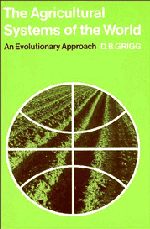Book contents
- Frontmatter
- Contents
- Acknowledgements
- 1 Introduction
- PART ONE
- PART TWO
- 5 Shifting agriculture
- 6 Wet-rice cultivation in Asia
- 7 Pastoral nomadism
- 8 Mediterranean agriculture
- 9 Mixed farming in western Europe and North America
- 10 Dairying
- 11 Plantations
- 12 Ranching
- 13 Large-scale grain production
- 14 Conclusions
- Appendix: Regions of plant domestication
- Notes
- Bibliography
- Index
13 - Large-scale grain production
Published online by Cambridge University Press: 10 March 2010
- Frontmatter
- Contents
- Acknowledgements
- 1 Introduction
- PART ONE
- PART TWO
- 5 Shifting agriculture
- 6 Wet-rice cultivation in Asia
- 7 Pastoral nomadism
- 8 Mediterranean agriculture
- 9 Mixed farming in western Europe and North America
- 10 Dairying
- 11 Plantations
- 12 Ranching
- 13 Large-scale grain production
- 14 Conclusions
- Appendix: Regions of plant domestication
- Notes
- Bibliography
- Index
Summary
In most agricultural systems based upon cultivation, grains are the major crops grown, and of these wheat and rice are of most importance. Rice is, however, with a few exceptions, the product of only one farming system, whereas wheat is a major crop in a number of systems. It is, for example, a staple crop in the smallscale, labour-intensive farms of northern India and northern China; it is grown as part of mixed farming systems in western Europe, and in the Mediterranean iands, whilst in parts of South West Asia it is grown in a manner hardly changed for the last four millennia. But the concern of this chapter is with the commercialised, mechanised and large-scale production of grains.
Wheat is still the major cash crop grown in large-scale grain production, and was of even more importance in the nineteenth century. Wheat and rye are the only crops from which bread flour can be made, and wheat flour is also used for a wide variety of pastries, cakes and pastas. It is more palatable than rye flour, and has always fetched a higher price; oats and barley have more limited uses for human food, and are grown mainly as fodder crops and for brewing. Prices for wheat are high compared with other grains, and in the long term, comparatively stable, for in the nineteenth century it was a major food for European populations, and it has become so for an increasing proportion of Asians in the last thirty years. Compared with other food crops it can be stored without spoiling, and transported over long distances fairly easily.
- Type
- Chapter
- Information
- The Agricultural Systems of the WorldAn Evolutionary Approach, pp. 256 - 283Publisher: Cambridge University PressPrint publication year: 1974

